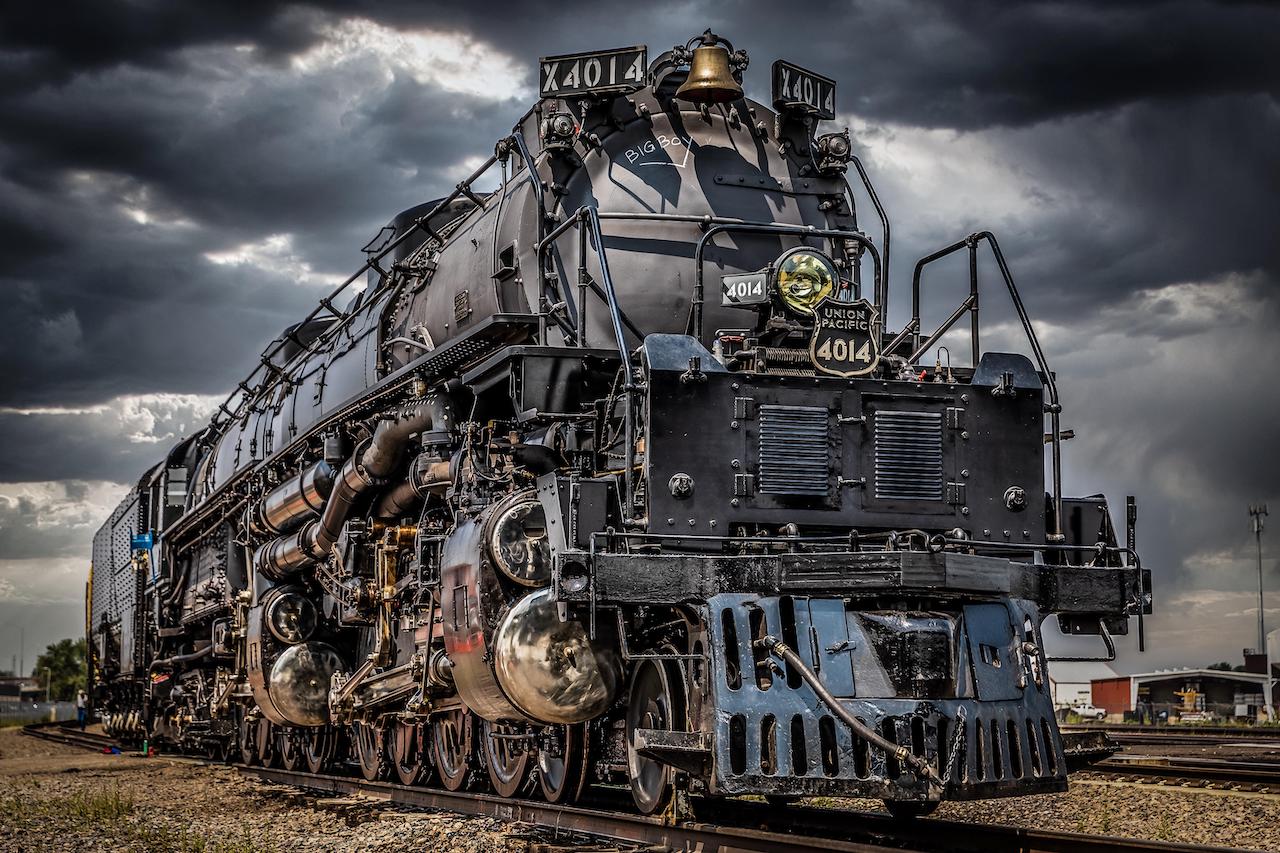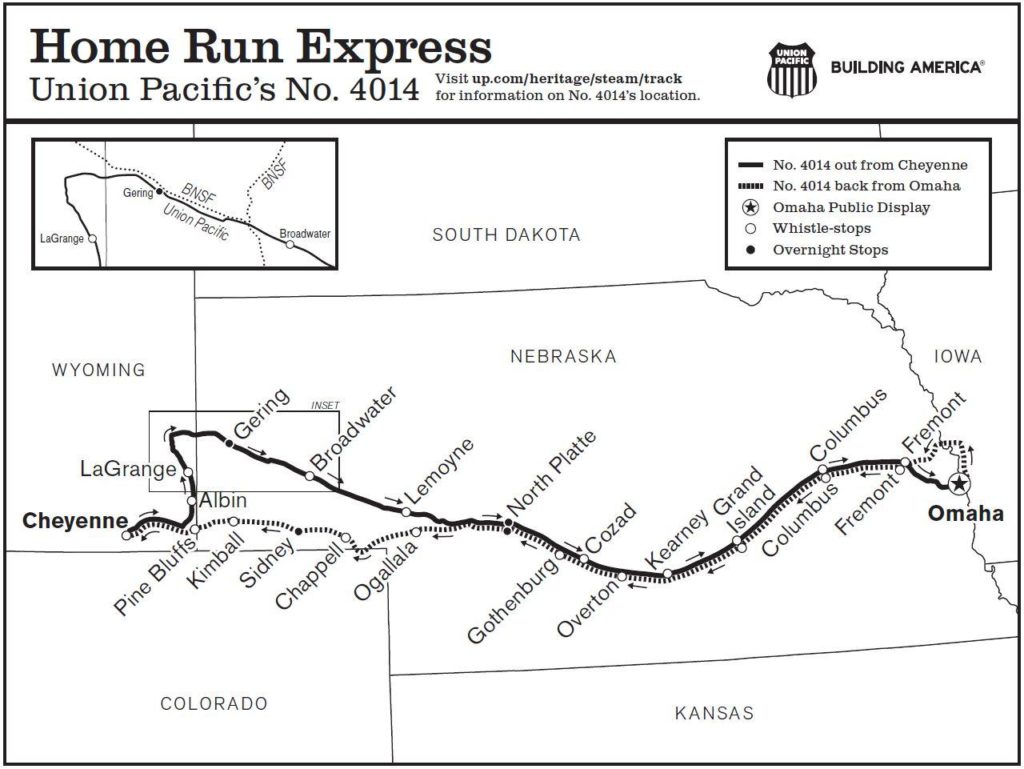
Class I Briefs: UP, CSX
Written by Carolina Worrell, Senior Editor
UP'S Big Boy No. 4014 will return to the rails on June 7.
Union Pacific’s (UP) famed steam locomotive, “Big Boy No. 4014”, returns to the rails on June 7. Also, 30 tons of ammonium nitrate being transported by UP that went missing on a rail shipment from Wyoming to California in April has still not been found, according to a New York Times report; and CSX is recognized as the "top-performing railroad in North America" by the Journal of Commerce.
UP announced May 19 that its famed Big Boy No. 4014, the world’s largest steam locomotive, is returning to the rails on June 7 for its Home Run Express Tour to Omaha, Neb., where it will be on display for 11 days during the college baseball championship.
The 1.1-million-pound locomotive that was built to haul heavy freight during World War II can be viewed at Home Plate next to Charles Schwab Field in Omaha from June 15-25, with numerous whistle-stops planned along its journey from Cheyenne, Wyo., to the ballpark.
According to UP, baseball shares a deep connection with railroads, dating back to the late 1800s. As the sport grew, players and fans relied upon rail to travel long distances for games. By 1876, game times were being scheduled to coincide with train schedules.
“The Big Boy is a special piece of UP’s history that played a vital role in helping carry the nation through World War II and reminds us of rail’s continued role in the U.S. economy,” said UP Senior Vice President-Corporate Relations and Chief Administrative Officer Scott Moore. “We are delighted to provide rail enthusiasts and baseball fans alike the opportunity to bask in the glory of two distinctly American passions, experiencing the rich history of rail and the thrill of a baseball game.”

Big Boy, which will leave Cheyenne, Wyo., on June 7, will make numerous whistle-stops in Wyoming and Nebraska before returning to its home base on July 3. During its Omaha display, the public will be allowed to see the locomotive up close between June 15-21 and June 24-25 from 12 p.m. to 6 p.m.
Scheduled whistle-stops and public displays include:
- June 7: Albin and LaGrange, Wyo., overnight in Gering, Neb.
- June 8: Broadwater and Lemoyne, Neb., overnight in North Platte.
- June 9: North Platte layover.
- June 10: Cozad, Kearney and Grand Island.
- June 1: Columbus and Fremont.
- June 15-2: Omaha, public display.
- June 24-25: Omaha, public display.
- June 29: Fremont, Columbus and Grand Island.
- June 30: Overton and Gothenburg, overnight in North Platte.
- July 1: North Platte layover.
- July 2: Ogallala and Chappell, overnight in Sidney.
- July 3: Kimball, Neb., and Pine Bluffs, Wyo.
Twenty-five Big Boy locomotives were built for UP to haul freight over the steep grade of the Wasatch Mountain Range in Utah during World War II. Eight were preserved after the locomotive was retired six decades ago, but only Big Boy No. 4014 is still in operation.
The locomotive was restored for 2019’s “Great Race” tours to celebrate the 150th anniversary of the transcontinental railroad’s completion. In 2021, Big Boy brought out more than one million people to see the engine as it traveled through 10 southern and midwestern states, including Texas and Louisiana, followed by a special trip in 2022 to Union Station in Denver, Colo., as part of Cheyenne’s Frontier Days.
A steam tracking map showing No. 4014’s location and route will be available at upsteam.com.
Separately, about 60,000 pounds of ammonium nitrate, a chemical used as a fertilizer and in explosives, that went missing on a UP rail shipment from Wyoming to California in April has still not been found, according to officials and as reported by The New York Times.
According to the report, Dyno Nobel, an explosive manufacturing company, notified the federal government of the loss and said in a statement that it was “investigating what happened during the nearly two-week journey.”
The company said the rail car with the material, which, according to The New York Times report, is “relatively harmless by itself but has caused deadly explosions in industrial accidents and has been used in targeted attacks,” was sealed when it left a manufacturing site in Cheyenne, Wyo., and the seals “were still intact” when it arrived in Saltdale, Calif.
“The initial assessment is that a leak through the bottom gate on the rail car may have developed in transit,” the statement said.
According to The New York Times, a report made on May 10 to the National Response Center, a federal emergency call center for railroad incidents, said that the rail car “left Wyoming on April 12 and arrived in California empty.”
Dyno Nobel, according to the report, said that the rail car was “transported back to Wyoming for further investigation and that it had ‘limited control’ of the train’s activity while the cargo was being transported.”
UP spokeswoman Kristen South stated that the company’s investigation was in its “early stages,” and added that UP “does not suspect that any criminal or malicious activity was involved in the disappearance of the cargo.
“The fertilizer is designed for ground application and quick soil absorption,” South said. “If the loss resulted from a rail car leak over the course of transportation from origin to destination, the release should pose no risk to public health or the environment.”
According to The New York Times, the Federal Railroad Administration (FRA) and the California Public Utilities Commission are also investigating, KQED, a San Francisco radio station, reported. As of May 21, the agencies could not be reached for comment.
CSX on May 19 announced that it has been recognized by intermodal providers as the “top-performing railroad in North America,” according to a Journal of Commerce survey. The “Intermodal Service Scorecard” ranking was compiled by the Journal of Commerce and assessed performance through the first four months of 2023.
To create the Scorecard, UP says more than 100 shippers and intermodal marketing companies were invited to perform a satisfaction assessment. Respondents cited their satisfaction with domestic intermodal service as a key driver of CSX’s number one ranking. Customers highlighted improvements in the railroad’s fluidity, train speed and customer service.
“CSX is proud to be recognized by our customers for the quality of our service delivery,” said President and CEO Joe Hinrichs. “CSX’s service performance has returned to—or in many cases surpassed—our pre-pandemic levels. However, we know that we must demonstrate to our customers that we can provide a sustained high level of service. And I assure you that we’re committed to continually partnering with our customers to deliver solutions that meet their business needs.”
CSX recently reported first quarter intermodal trip plan compliance results above 95%, “demonstrating its strong record of meeting rail car scheduling plans,” the Class I said. The company’s improved service reliability was also cited by the Surface Transportation Board (STB) in its recent decision to release CSX from a temporary requirement for Class I railroads to submit bi-weekly service metrics reports. CSX is the only one of the Class Is to no longer be subject to the requirement.
More information regarding CSX’s ranking on the Journal of Commerce Intermodal Scorecard is available here.



